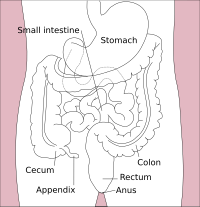
Photo from wikipedia
Aquatic animals under waterborne metal exposure are also very likely exposed to elevated dietary metals. This study quantified the simultaneous uptake of dietary and waterborne Cd in gastrointestinal tracts (GT)… Click to show full abstract
Aquatic animals under waterborne metal exposure are also very likely exposed to elevated dietary metals. This study quantified the simultaneous uptake of dietary and waterborne Cd in gastrointestinal tracts (GT) of marine yellowstripe goby using a dual stable isotope tracer method. The Cd spiked diet (10-100 μg g-1, 111Cd as tracers) were fed to the fish as a single meal, and then the fish were exposed to waterborne Cd (0-500 μg L-1, 113Cd as tracers) for 48 h, during which the time-course uptake of Cd in the stomach and intestine was determined. The findings revealed that the dietary Cd uptake mainly occurred within 12 h after feeding. The fish exposed to 500 μg L-1 waterborne Cd showed significantly lower Cd assimilation efficiency (2.07%) than the control group (3.48%) at the dietary Cd of 100 μg g-1. Moreover, during 4-12 h when there was chyme in the GT, the waterborne Cd uptake in the intestine was lowest but the stomach showed the highest waterborne Cd uptake rate. The uptake of dietary and waterborne Cd, and the relative importance of dietary vs waterborne Cd was positively correlated with the Cd concentration in the chyme. Overall, this research demonstrated that there was interaction between dietary and waterborne Cd uptake in the GT of marine fish. The simultaneous uptake of metal from two routes is far more complex than the situation of a single route of metal uptake, which should be evaluated in determining metal bioaccumulation and toxicity in both laboratory and field metal exposure scenario.
Journal Title: Environmental pollution
Year Published: 2017
Link to full text (if available)
Share on Social Media: Sign Up to like & get
recommendations!